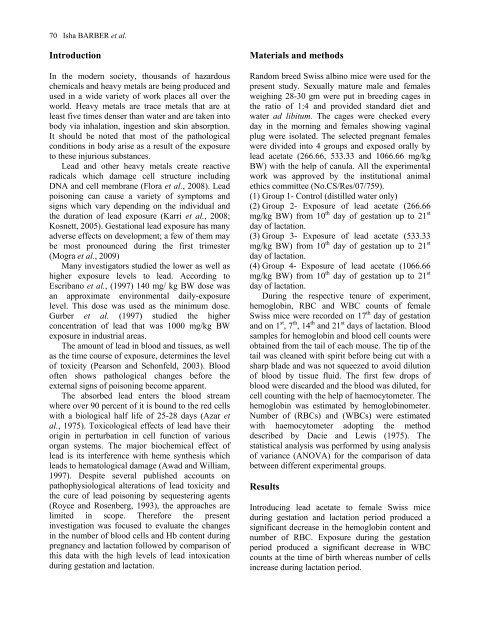Vol 9 No1 - Journal of Cell and Molecular Biology - Haliç Üniversitesi
Vol 9 No1 - Journal of Cell and Molecular Biology - Haliç Üniversitesi
Vol 9 No1 - Journal of Cell and Molecular Biology - Haliç Üniversitesi
You also want an ePaper? Increase the reach of your titles
YUMPU automatically turns print PDFs into web optimized ePapers that Google loves.
70 Isha BARBER et al.<br />
Introduction<br />
In the modern society, thous<strong>and</strong>s <strong>of</strong> hazardous<br />
chemicals <strong>and</strong> heavy metals are being produced <strong>and</strong><br />
used in a wide variety <strong>of</strong> work places all over the<br />
world. Heavy metals are trace metals that are at<br />
least five times denser than water <strong>and</strong> are taken into<br />
body via inhalation, ingestion <strong>and</strong> skin absorption.<br />
It should be noted that most <strong>of</strong> the pathological<br />
conditions in body arise as a result <strong>of</strong> the exposure<br />
to these injurious substances.<br />
Lead <strong>and</strong> other heavy metals create reactive<br />
radicals which damage cell structure including<br />
DNA <strong>and</strong> cell membrane (Flora et al., 2008). Lead<br />
poisoning can cause a variety <strong>of</strong> symptoms <strong>and</strong><br />
signs which vary depending on the individual <strong>and</strong><br />
the duration <strong>of</strong> lead exposure (Karri et al., 2008;<br />
Kosnett, 2005). Gestational lead exposure has many<br />
adverse effects on development; a few <strong>of</strong> them may<br />
be most pronounced during the first trimester<br />
(Mogra et al., 2009)<br />
Many investigators studied the lower as well as<br />
higher exposure levels to lead. According to<br />
Escribano et al., (1997) 140 mg/ kg BW dose was<br />
an approximate environmental daily-exposure<br />
level. This dose was used as the minimum dose.<br />
Gurber et al. (1997) studied the higher<br />
concentration <strong>of</strong> lead that was 1000 mg/kg BW<br />
exposure in industrial areas.<br />
The amount <strong>of</strong> lead in blood <strong>and</strong> tissues, as well<br />
as the time course <strong>of</strong> exposure, determines the level<br />
<strong>of</strong> toxicity (Pearson <strong>and</strong> Schonfeld, 2003). Blood<br />
<strong>of</strong>ten shows pathological changes before the<br />
external signs <strong>of</strong> poisoning become apparent.<br />
The absorbed lead enters the blood stream<br />
where over 90 percent <strong>of</strong> it is bound to the red cells<br />
with a biological half life <strong>of</strong> 25-28 days (Azar et<br />
al., 1975). Toxicological effects <strong>of</strong> lead have their<br />
origin in perturbation in cell function <strong>of</strong> various<br />
organ systems. The major biochemical effect <strong>of</strong><br />
lead is its interference with heme synthesis which<br />
leads to hematological damage (Awad <strong>and</strong> William,<br />
1997). Despite several published accounts on<br />
pathophysiological alterations <strong>of</strong> lead toxicity <strong>and</strong><br />
the cure <strong>of</strong> lead poisoning by sequestering agents<br />
(Royce <strong>and</strong> Rosenberg, 1993), the approaches are<br />
limited in scope. Therefore the present<br />
investigation was focused to evaluate the changes<br />
in the number <strong>of</strong> blood cells <strong>and</strong> Hb content during<br />
pregnancy <strong>and</strong> lactation followed by comparison <strong>of</strong><br />
this data with the high levels <strong>of</strong> lead intoxication<br />
during gestation <strong>and</strong> lactation.<br />
Materials <strong>and</strong> methods<br />
R<strong>and</strong>om breed Swiss albino mice were used for the<br />
present study. Sexually mature male <strong>and</strong> females<br />
weighing 28-30 gm were put in breeding cages in<br />
the ratio <strong>of</strong> 1:4 <strong>and</strong> provided st<strong>and</strong>ard diet <strong>and</strong><br />
water ad libitum. The cages were checked every<br />
day in the morning <strong>and</strong> females showing vaginal<br />
plug were isolated. The selected pregnant females<br />
were divided into 4 groups <strong>and</strong> exposed orally by<br />
lead acetate (266.66, 533.33 <strong>and</strong> 1066.66 mg/kg<br />
BW) with the help <strong>of</strong> canula. All the experimental<br />
work was approved by the institutional animal<br />
ethics committee (No.CS/Res/07/759).<br />
(1) Group 1- Control (distilled water only)<br />
(2) Group 2- Exposure <strong>of</strong> lead acetate (266.66<br />
mg/kg BW) from 10 th day <strong>of</strong> gestation up to 21 st<br />
day <strong>of</strong> lactation.<br />
(3) Group 3- Exposure <strong>of</strong> lead acetate (533.33<br />
mg/kg BW) from 10 th day <strong>of</strong> gestation up to 21 st<br />
day <strong>of</strong> lactation.<br />
(4) Group 4- Exposure <strong>of</strong> lead acetate (1066.66<br />
mg/kg BW) from 10 th day <strong>of</strong> gestation up to 21 st<br />
day <strong>of</strong> lactation.<br />
During the respective tenure <strong>of</strong> experiment,<br />
hemoglobin, RBC <strong>and</strong> WBC counts <strong>of</strong> female<br />
Swiss mice were recorded on 17 th day <strong>of</strong> gestation<br />
<strong>and</strong> on 1 st , 7 th , 14 th <strong>and</strong> 21 st days <strong>of</strong> lactation. Blood<br />
samples for hemoglobin <strong>and</strong> blood cell counts were<br />
obtained from the tail <strong>of</strong> each mouse. The tip <strong>of</strong> the<br />
tail was cleaned with spirit before being cut with a<br />
sharp blade <strong>and</strong> was not squeezed to avoid dilution<br />
<strong>of</strong> blood by tissue fluid. The first few drops <strong>of</strong><br />
blood were discarded <strong>and</strong> the blood was diluted, for<br />
cell counting with the help <strong>of</strong> haemocytometer. The<br />
hemoglobin was estimated by hemoglobinometer.<br />
Number <strong>of</strong> (RBCs) <strong>and</strong> (WBCs) were estimated<br />
with haemocytometer adopting the method<br />
described by Dacie <strong>and</strong> Lewis (1975). The<br />
statistical analysis was performed by using analysis<br />
<strong>of</strong> variance (ANOVA) for the comparison <strong>of</strong> data<br />
between different experimental groups.<br />
Results<br />
Introducing lead acetate to female Swiss mice<br />
during gestation <strong>and</strong> lactation period produced a<br />
significant decrease in the hemoglobin content <strong>and</strong><br />
number <strong>of</strong> RBC. Exposure during the gestation<br />
period produced a significant decrease in WBC<br />
counts at the time <strong>of</strong> birth whereas number <strong>of</strong> cells<br />
increase during lactation period.

















